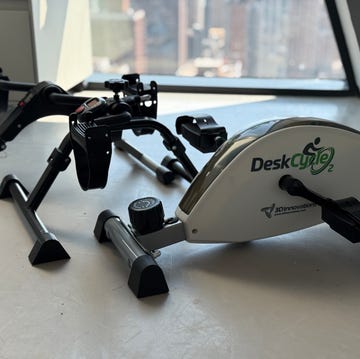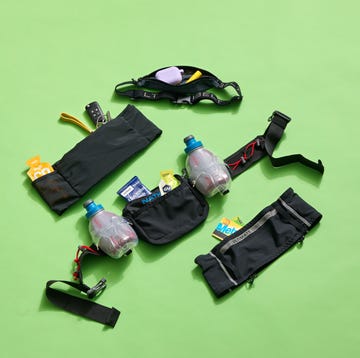It seems like there is a new smart fitness gadget coming out every day claiming to give you a gym-quality workout at home. As a personal trainer and avid CrossFitter, I've tried more than my fair share, and to be honest, most don't live up to the hype. However, I found Tonal's original smart home gym extremely effective for strength training at home, so I was excited to get my hands on their second-gen system. But the price tag is steep, so I wanted to test it to see if it's worth the investment. Here's my hands-on review, plus a comparison to its competitors.
Dimensions: 50.9" H x 21.5" W x 5.25" D | Interface: 24” touchscreen | Product weight: 150 lbs | Maximum resistance: 250 lbs
What is Tonal 2?
The second-generation version of the Tonal smart home gym, this wall-mounted fitness system features a large touchscreen interface that connects to two adjustable arms. Those arms offer electromagnetic resistance technology, which lets you push and pull actual weight without dumbbells and other free weights to clutter up your living room. The machine also connects to optional workout accessories that attach to the arms, like a bar, handles, rope, bench and mat, so that you can perform practically any strength training movement. You can follow virtual classes led by Tonal's trainers and even customize your workout on the platform. Tonal 2 tracks reps, sets, time under tension, range of motion and more.
What is the difference between Tonal 2 and the original?
This newer version goes up to 250 pounds of resistance (125 pounds per arm), whereas the original went up to 200 pounds. It has a sleeker design, though very similar to the original, and a 75% stronger cable than the first model, according to the brand. Other main differences include adaptive drop sets — Tonal can sense that you're fatiguing in a set and automatically drop the weight to the ideal amount for you in real time so you can push through.
You'll also notice a new camera on the front of the machine that uses AI to provide coaching cues to improve your form (the previous model gave coaching cues, but you had to use your phone for this). Another new feature is Aero HIIT workouts — since the new Tonal offers a tricep rope that attaches to both arms, this can be used for different HIIT movements that mimic a similar motion to what you would perform on a ski erg.
How much does Tonal 2 cost?
The machine is a major investment at $4,295 plus $495 for the Smart Accessories bundle, which includes the smart handles, bar, rope, bench, workout mat and roller. At the time of this review, the machine is currently on sale for $3,795. There is an optional monthly membership of $59.95/month to access everything on the platform. You can use the machine without a membership but will only be able to access Basic Life mode, which includes training utilizing the bar, rope and handle, adjusting the weight using a weight dial, and viewing your rep count on a rep counter (movement demos, weight suggestions and dynamic weight modes will be unavailable without a membership).
Tonal delivers to all 50 United States and ships units three to five weeks after purchase. Their team professionally installs the machine, but shipping and installation charges are in the $250 ballpark, so you're looking at roughly $5K for initial costs plus a $60 monthly membership fee.
First impressions: Delivery and setup
I tried the Tonal 2 at their pop-up studio in downtown NYC and then installed one in my home to test long-term. Receiving a Tonal is different than most fitness equipment, like a treadmill or bike, because it needs to be mounted to a wall and has specific space requirements that must be met. Tonal recommends 7 feet by 7 feet of floor space, 7 feet of unobstructed wall space, and a ceiling height of at least 7 feet and 10 inches (you can reference their space requirements for more specific information).
Tonal sent me thorough communication before the delivery to prepare for the installation. The delivery team that brings and installs the device in your home is a separate third party, but I was very impressed with the professionals who delivered and installed my Tonal. They said they primarily install Tonal machines, and I could tell they were experienced just by how they assessed the space in my basement where I wanted to place the Tonal. My basement is unfinished, and the delivery team was able to mount the machine to the solid concrete wall (which was no easy task). They also left the space clean and tidy after the installation.
Out of the box, I noticed that the Tonal 2 looks very similar to its predecessor but a bit sleeker and sophisticated due to its all-black design. But to be honest, there aren't any tremendous design changes to the product, and I get why — as the old saying goes, if it ain't broke, don't fix it. Tonal 2 has a relatively compact design, which I appreciate since I have kids in our home, and it's a nice alternative to having loose fitness equipment all over the basement. I received a few accessories with the machine, like a bench and the new dual T-lock rope (essentially a triceps rope that attaches to both arms), which all felt premium and durable.
Putting Tonal to the test: How it works
User experience
I found the initial setup to be intuitive and straightforward. Onboarding is simple, and I could easily log in since I have previously trained with Tonal. The machine establishes your starting strength with an initial assessment and then automatically recommends weights for each movement based on this assessment. And as you get stronger, Tonal will automatically increase the weights to help you push harder. I love this feature because it takes the guesswork out of weightlifting — the machine picks the perfect weights for you (and grows with you) so you can just get up and lift.
AI coaching
As a personal trainer, I have one issue with home workouts: Form can be sacrificed. If you're not experienced or don't have a qualified fitness professional with you, it's hard to know if you are doing the exercise movements correctly. Tonal 2 has a new built-in camera that uses AI to assess your whole body during the workouts and provide coaching cues on your form and technique. The previous model offered this, but you had to use the camera on your phone, so it's nice that this is now built-in. I love technology like this, which can ensure you're getting an effective workout at home and a safe one.
Workout options
If you're worried about 250 pounds (125 pounds per arm) not being sufficient for your workouts, remember that lifting digital weights does feel more challenging than free weights because there is no momentum assisting you. Even my husband, a very experienced weightlifter, gets a great workout on Tonal. There are certain movements, such as a back squat, where he usually lifts heavier, but he can still get a very effective workout on the Tonal 2, which he hasn't been able to experience on other home gym set-ups we have tried.
The resistance is smooth, and Tonal, in general, offers some useful features like spotter mode, which will reduce the weight if you are struggling on a rep, so you feel safe during your lifts at home. Eccentric mode adds weight for the lowering portion of the exercise for maximum gains, which you wouldn't be able to do with a set of free weights. The chains mode does the opposite, increasing resistance during the exercise's concentric (lifting) portion. The adaptive drop sets are probably my favorite feature — Tonal 2 will automatically sense you are fatigued and lower the weight in real time so you can get in more reps to near-failure and stimulate muscle growth.
Tonal 2 offers everything from one-off instructor-led classes (over 3,000 and counting) to multi-week programs. You'll find everything from strength to high-intensity workouts, yoga, mobility and recovery on the platform. As a personal trainer, I can vouch for Tonal's top-quality fitness content and instructors. Some of my favorites are Coach Nicolette, Coach Tim and Coach Ackeem. They are doing the entire workout with you, which helps you visually understand how to transition from one movement to the next and is extremely motivating. But if you want to do your own thing, Tonal 2 offers Free Lift mode to choose your own exercises and weights/reps. That being said, you're paying a premium for Tonal's top-tier coaches, so I recommend utilizing them to get the most out of this machine. You'll also find Tonal in 57 hotels nationwide — my Dad was recently in Texas on a business trip and was able to use the Tonal in his hotel gym, which is pretty neat.
Tonal vs. other home gyms
Tempo is one of Tonal's biggest competitors and was the OG of AI form guidance, which Tonal now offers with the built-in camera on their device. However, Tonal has resistance built into the machine, whereas Tempo requires free weights like barbells and plates that you use at the gym, so those need to be stored separately in your home. I am a fan of Tempo's setup and technology; their instructors are seasoned in strength training techniques.
Vitruvian is another strength training platform that goes up to a whopping 440 pounds of resistance — I've tested it in the past, and the machine is no joke; it provides a serious amount of weight and is surprisingly versatile, but it appears that you can't purchase it at the moment. That's the issue with some of these digital platforms – especially ones that incur a monthly membership fee, you want to ensure that they will stand the test of time, and Tonal's membership base and platform have been going strong and seem pretty solid to me at the moment.
There is also the Speediance Gym Monster 2, which we are currently testing and find extremely effective for intense strength training. You can get a lot done on this machine, and the attachments provide a ton of versatility (even rowing is an option, which is neat). The most significant difference between the two is that the Gym Monster 2 does not need to be mounted on a wall like Tonal, which could be a key determining factor for some. It goes up to 220 pounds, whereas Tonal is slightly higher at 250 pounds. But Tonal's structure, materials and cables are a bit more premium and durable — in our Speediance tests, we found signs of wear and tear on the machine only after a couple of uses. The cable covering is made of cotton fabric and has already frayed significantly. That being said, it's still a decent product with a ton of functional fitness use and comes at a lower price than Tonal. Another similar option is the Echelon Strength Pro, which we have yet to test but is even more expensive than Tonal and Speediance, coming in at $6K.
Tonal 2 pros and cons
Pros:
- Sleek, sophisticated design
- Intuitive and easy-to-use interface
- Easy onboarding process
- Compact footprint when not in use
- Resistance now goes up to 250 pounds
- Built-in AI coaching provides feedback and form cues
- Weight adapts to your strength level
- Safety features like spotter mode
Cons:
- Expensive initial cost and steep monthly membership
- Specific space requirements
- Needs to be mounted to a wall
FAQs
Is Tonal good for strength training?
Definitely. Strength training is at the core of the brand's model, and the equipment offers some pretty cool features. Eccentric mode, for instance, increases the resistance during the exercise's eccentric phase (lowering) and then removes it for the upward phase. This type of training isn't possible with a standard set of dumbbells or a barbell.
But you may be worried about safety with the machine — what happens if you lift something too heavy and can't complete the rep? Tonal has a key feature called Spotter mode, which automatically senses if you are struggling to complete a rep and temporarily lowers the weight so you can finish the set. And if you are new to strength training, no worries. Lifting weights in the gym can be intimidating, but since Tonal provides guidance and feedback, you don't need to be a lifting expert to use it, and you'll certainly get a lot out of the instructor-led classes and AI form feedback cues.
Can Tonal replace a gym membership?
It certainly can, but you'll miss out on the community aspect of exercising alongside other gym-goers (though Tonal does offer an option for partner workouts). The Centers for Disease Control and Prevention's exercise recommendations include at least two days of weight training and at least 150 minutes of moderate cardio (or 75 minutes of vigorous cardio) each week. While Tonal focuses on weight training, their cardio programs include high-intensity training, bootcamp, boxing, kickboxing, dance cardio and now Aero for functional HIIT movements. As for strength training, all your muscle-building needs will be met here, and the equipment offers lots of freedom and function. Plus, it's very easy to switch handles and transition between movements. Tonal can also provide precise targeting for special fitness needs, and the convenience of having it right at home can be a game-changer for your workout regimen.
Final thoughts: Is Tonal 2 worth it?
Whether or not Tonal is worth it ultimately depends on how dedicated you are to using the system. It's definitely a best-in-class home gym and one of the most impressive fitness equipment I have tested. And the resistance now going up to 250 pounds means it's substantial enough even for most serious athletes to get a hardcore workout at home. But the hefty start-up cost is a significant investment, plus the monthly membership fee, which is one of the highest I have seen, and you really won't get the most out of this machine without it. Considering that the average fee for a gym membership in the US can range from $120 to $1,000 a year, you should calculate whether to spring for Tonal based on cost-per-use. Is working out at home something you enjoy and will do regularly? Do you need the guesswork eliminated for you? If so, Tonal 2 and its in-home convenience could be perfect for you and you'll certainly see strength gains if you use it consistently.
Why trust Good Housekeeping?
Stefani Sassos, a NASM-certified personal trainer and Women's Fitness Specialist, has over 10 years of experience in the fitness industry, specializing in indoor cycling and strength training. At the Good Housekeeping Institute, she leverages her expertise to create informed fitness content, from testing exercise equipment and apps to curating workout plans.
Stefani (she/her) is a registered dietitian, a NASM-certified personal trainer and the director of the Good Housekeeping Institute Nutrition and Fitness Lab, where she oversees all nutrition and fitness-related content, testing and evaluation. She holds a master’s degree in clinical nutrition from New York University, as well as advanced certifications as a Women's Fitness Specialist and a Behavior Change Specialist. Stefani is dedicated to providing readers with evidence-based content to encourage informed food choices and healthy living. She is an avid CrossFitter and a passionate home cook who loves spending time with her big fit Greek family.























